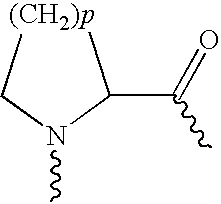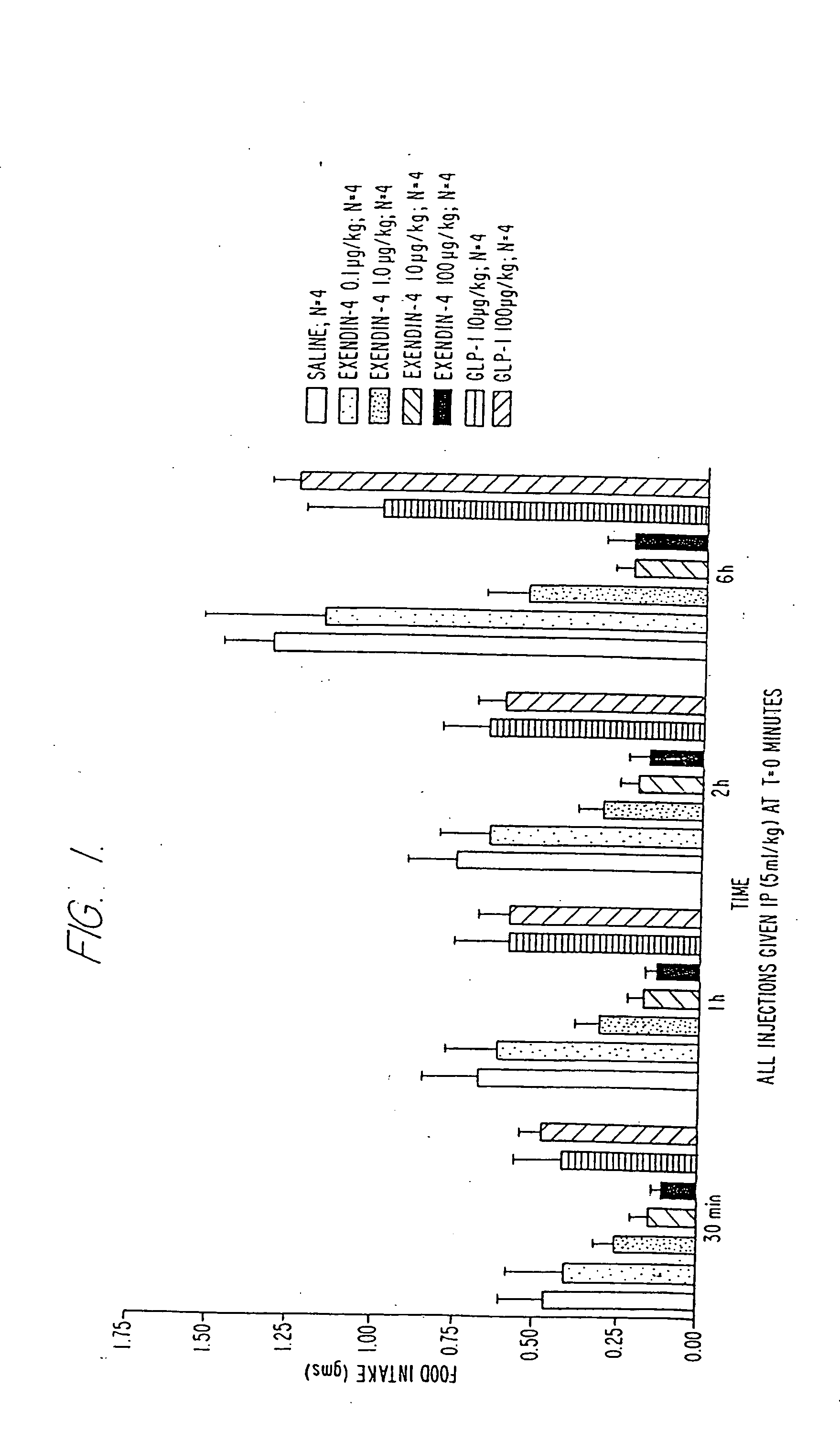Use of exendins and agonists thereof for lowering plasma lipid
a technology of exendins and lipids, which is applied in the direction of peptide sources, inorganic non-active ingredients, metabolic disorders, etc., can solve the problems of inability to reduce food intake, inability to achieve a balanced diet, etc., to achieve a profound and prolonged effect of inhibiting food intak
- Summary
- Abstract
- Description
- Claims
- Application Information
AI Technical Summary
Benefits of technology
Problems solved by technology
Method used
Image
Examples
example 1
Exendin Injections Reduced the Food Intake of Normal Mice
[0190] All mice (NIH:Swiss mice) were housed in a stable environment of 22 (∀ 2)° C., 60 (∀10) % humidity and a 12:12 light:dark cycle; with lights on at 0600. Mice were housed in groups of four in standard cages with ad libitum access to food (Teklad: LM 485; Madison, Wis.) and water except as noted, for at least two weeks before the experiments.
[0191] All experiments were conducted between the hours of 0700 and 0900. The mice were food deprived (food removed at 1600 hr from all animals on day prior to experiment) and individually housed. All mice received an intraperitoneal injection (5 μl / kg) of either saline or exendin-4 at doses of 0.1, 1.0, 10 and 100 μg / kg and were immediately presented with a pre-weighed food pellet (Teklad LM 485). The food pellet was weighed at 30-minute, 1-hr, 2-hr and 6-hr intervals to determine the amount of food eaten.
[0192]FIG. 1 depicts cumulative food intake over periods of 0.5, 1, 2 and 6 ...
example 2
Exendin Reduced the Food Intake of Obese Mice
[0194] All mice (female ob / ob mice) were housed in a stable environment of 22 (∀2)° C., 60 (∀10) % humidity and a 12:12 light:dark cycle; with lights on at 0600. Mice were housed in groups of four in standard cages with ad libitum access to food (Teklad: LM 485) and water except as noted, for at least two weeks before the experiments.
[0195] All experiments were conducted between the hours of 0700 and 0900. The mice were food deprived (food removed at 1600 hr from all animals on day prior to experiment) and individually housed. All mice received an intraperitoneal injection (5 μl / kg) of either saline or exendin-4 at doses of 0.1, 1.0 and 10 μg / kg (female ob / ob mice) and were immediately presented with a pre-weighed food pellet (Teklad LM 485). The food pellet was weighed at 30-minute, 1 -hr, 2-hr and 6-hr intervals to determine the amount of food eaten.
[0196]FIG. 2 depicts the effect of exendin-4 in the ob / ob mouse model of obesity. The...
example 3
Intracerebroventricular Injections of Exendin Inhibited Food Intake in Rats
[0197] All rats (Harlan Sprague-Dawley) were housed in a stable environment of 22 (∀2)° C., 60 (∀10)% humidity and a 12:12 light:dark cycle; with lights on at 0600. Rats were obtained from Zivic Miller with an intracerebroventricular cannula (ICV cannula) implanted (coordinates determined by actual weight of animals and referenced to Paxinos, G. and Watson, C. “The Rat Brain in stereotaxic coordinates,” second edition. Academic Press) and were individually housed in standard cages with ad libitum access to food (Teklad: LM 485) and water for at least one week before the experiments.
[0198] All injections were given between the hours of 1700 and 1800. The rats were habituated to the ICV injection procedure at least once before the ICV administration of compound. All rats received an ICV injection (2 μl / 30 seconds) of either saline or exendin-4 at doses of 0.01, 0.03, 0.1, 0.3, and 1.0 μg. All animals were the...
PUM
| Property | Measurement | Unit |
|---|---|---|
| plasma lipid | aaaaa | aaaaa |
| insulin-resistance | aaaaa | aaaaa |
| weight | aaaaa | aaaaa |
Abstract
Description
Claims
Application Information
 Login to View More
Login to View More - R&D
- Intellectual Property
- Life Sciences
- Materials
- Tech Scout
- Unparalleled Data Quality
- Higher Quality Content
- 60% Fewer Hallucinations
Browse by: Latest US Patents, China's latest patents, Technical Efficacy Thesaurus, Application Domain, Technology Topic, Popular Technical Reports.
© 2025 PatSnap. All rights reserved.Legal|Privacy policy|Modern Slavery Act Transparency Statement|Sitemap|About US| Contact US: help@patsnap.com



